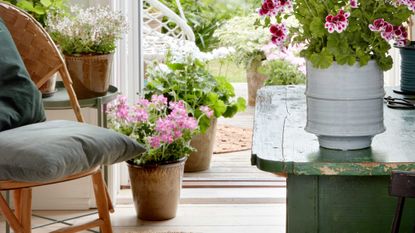How to overwinter plants – where and when to do this gardener's trick to help planting survive the cold
Expert gardeners reveal how to successfully overwinter your backyard this year for a healthy start to your garden in spring


As the months march on and the temperature drops, you might be starting to have concerns over some of your outdoor plants, especially if a freeze comes onto the forecast. Gardening at this time is essential to keep your backyard healthy through winter and ready for spring, and for some plants "overwintering" is vital, but what is it?
Overwintering isn't necessary for all plants however it will keep your most delicate plants protected from the harsh winter weather. Ornamental grasses, citrus trees, and other tropical plants are the focus of many modern gardens, making it an important technique to get to grips with.
We quizzed gardening experts on the overwintering method to find out what it is, when we should do it, and how to do it effectively. If you are going to do anything with your garden this month, let it be this.
What is overwintering?
Gardening jargon is often guilty of overcomplicating things, but overwintering really is what is said on the tin. It is about caring for your plants over winter. 'Overwintering is the practice of protecting plants from the cold during the winter months,' says gardening professional and co-founder of GreenPal, Gene Caballero, 'particularly those that are not naturally suited to withstand the freezing temperatures.'
Overwintering can involve different measures, but generally, it means moving the vulnerable plants inside over winter. If the plants cannot easily be moved there are alternative methods to keep them healthy. 'Mulching, or using protective coverings to insulate them from the cold,' can also work, says Gene. Ideally, your most vulnerable plants can be moved around to give them the best protection. This doesn't, however, mean that you should just plonk them in front of your fireplace.
Where is best to overwinter plants?

When you discover overwintering, you might think it means bringing your beloved plants into your warm home. However, to do this would be a big mistake. There are specific places to take your plants for overwintering that will not damage them in the short term and will contribute to their health over the winter.
'The best location for overwintering plants depends on the specific requirements of the plant and the space you have available,' says professional gardener Zahid Adnan from The Plant Bible. Depending on the specific plant there are a few places that would make the ideal location for your plants over winter. 'For tender plants, bring them into a heated greenhouse or inside your home, ensure you provide adequate light and monitor humidity levels,' says Zahid. This should only be done for the most delicate plants and they should not be put directly in front of any heat sources.
There are some generic spaces that make good spots for overwintering too. 'In general, a basement, garage, or indoor space that remains cool but not freezing is ideal,' says Gene. 'These locations protect plants from harsh conditions while providing the cooler temperatures that many plants require during their dormant period,' he explains. If in doubt look for spaces that are dry and don't succumb to freezing temperatures.
When should I start overwintering?

There isn't a strict time to overwinter as it largely depends on your climate and when the freezing conditions begin, however there are general rules you can follow. 'A good rule of thumb is to start your preparations in late autumn, before the first frost,' says Lindsey Hyland, founder of the Urban Organic Yield. 'This gives your plants ample time to adjust to the changes and ensures they're well-protected against the harsh winter conditions,' she explains.
As with all gardening techniques it is important to be responsive to your environment and plants to keep you backyard looking good through winter. Some plants may need to be overwintered earlier than other, and some might not need it at all. Now you are equipped with the knowledge to adequately care for your plants over winter they will be ready for a hive of activity come spring.
What you need for overwintering

Quantity: 2 cubic ft
Price: $3.98

Size: 10 inch
Price: $17.49

Size: 31" x 40"
Price: $42.99
Be The First To Know
The Livingetc newsletter is your shortcut to the now and the next in home design. Subscribe today to receive a stunning free 200-page book of the best homes from around the world.

Amy recently completed an MA in Magazine Journalism at City, University of London, with experience writing for Women’s lifestyle publications across arts, culture, and beauty. She has a particular love for the minimalist aesthetic mixed with mid-century furniture, especially combining unique vintage finds with more modern pieces. Her previous work in luxury jewellery has given her a keen eye for beautiful things and clever design, that plays into her love of interiors. As a result, Amy will often be heard justifying homeware purchases as 'an investment', wise words to live by.
-
 How to Thaw a Frozen Pipe — Learn Everything You Need to Know in 5 Minutes With This Guide
How to Thaw a Frozen Pipe — Learn Everything You Need to Know in 5 Minutes With This GuideWinter storm caught you off guard? We asked an expert — just how do you thaw a frozen pipe?
By Hugh Metcalf Published
-
 The 12 Very Best Silk Bedding Pieces — As Our Style Editor Says: 'It's What Dreams Are Made Of!'
The 12 Very Best Silk Bedding Pieces — As Our Style Editor Says: 'It's What Dreams Are Made Of!'Slumber in lustrous luxury with the very best silk bedding sheets, duvets, pillowcases, and more — your sleep score will thank us later
By Julia Demer Published

